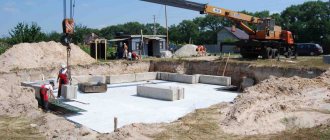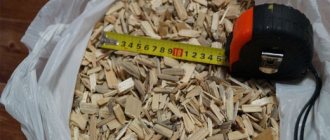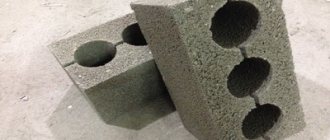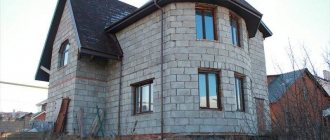Traditionally, cold asphalt is used for pothole repair. It is assumed that this is a temporary measure to correct uneven areas in the area. Therefore, if you need to fill a small hole in the yard or on the road, pay attention to the cold variety. This material is stored for a long time, can be used in small portions, and working with it does not require extensive experience or special equipment.
Next, we will tell you how to properly lay cold asphalt and what to pay attention to when laying. You will also learn at what temperature the material can be used and what the limitations are.
But first it’s worth saying that there are two types of cold asphalt:
- Classic It is usually sold in bags in small portions (25 and 30 kg) or in bulk.
- Hot with plasticizers It differs from classic hot asphalt in the presence of plasticizers, thanks to which it cools down longer (within 10 hours). This variety is sold hot (temperature 80-140°C).
In this article we will talk in detail about the method of laying the first, classic type of cold asphalt. And you can read about how to work with the second type of material on the page Technology for laying hot asphalt
Most often it is used:
- For pothole repairs of roads with medium and low traffic
- When repairing asphalt surfaces of yards, squares, sidewalks
Read on to find out what materials you may need and what are the features of cold asphalt laying technology.
The main differences between cold and hot asphalt
Cold asphalt differs from standard hot-mix asphalt in many ways. First of all, this is the possibility of year-round use, without temperature restrictions. Other differences include:
- Production method . Cold paving mixtures can be produced without heating the components.
- Temperature of the mixture during work. Low-temperature technology involves using materials cold, without heating, so they are simpler and safer to use.
- Compound . Instead of viscous bitumen, more liquid bitumen compositions are used.
- Solidification process . Hot asphalt concrete hardens as it cools, and cold mixtures gain strength during the gradual evaporation of plasticizing additives.
By purpose:
- Hot asphalt concrete is universal and is applicable both when performing repair work and for continuous asphalt paving when laying new roads.
- Cold asphalt concrete , due to its lower strength, is optimal for pothole repairs and asphalting of small, lightly loaded areas. Another common application is the creation of flooring for hatches, since due to its pronounced plasticity, such a coating is not prone to cracking.
Due to its unpretentiousness to weather conditions and a number of other advantages, cold asphalt concrete has a fairly high cost. However, when deciding on the profitability of its use, one must take into account that real costs are reduced due to savings on delivery, the absence of heavy equipment and the minimum number of workers in repair teams (to ensure a full-fledged work process, it is enough to use 2-3 people).
Installation materials
You don't need a lot of materials to repair potholes in your yard or on the road. So, if the depth of the hole is up to 20 cm, you will not need anything other than cold asphalt.
If the pothole depth exceeds 20 cm, you can additionally purchase:
- Crushed stone
- Bitumen
Next we will briefly explain what these materials are and why they are needed.
Crushed stone
It is needed to fill the bottom of the hole and save money on rather expensive cold asphalt. In addition, crushed stone provides better adhesion between the asphalt and the base and gives strength to the repaired surface. Thanks to the crushed stone cushion, the asphalt will not sag under pressure.
Please note that crushed stone can consist of grains of different sizes. Some large rocks may even exceed the size of your hole. Therefore, be sure to pay special attention to the fraction of the material.
The best option for filling the hole would be crushed stone with a grain size of up to 40 mm.
These may be factions:
- 5-10
- 5-20
- 5-25
- 10-20
- 20-40
In this case, you can combine different fractions, filling the voids between large stones with smaller ones (that is, doing clinching).
As for the rock, we advise you to opt for inexpensive materials: granite or crushed limestone. After all, it makes no sense to buy expensive types for pothole repair. But, of course, you can take other types of crushed stone (diorite, serpentinite, amphibolite and others). The only thing is to take into account the strength of the material (it is designated by the letter “M”). Ideally, it should be from M600 (medium strength) and higher. Then the material will be able to withstand sufficient loads.
Bitumen
The binder component is usually used in the repair of federal highways and highways with high traffic. It is needed for better adhesion of asphalt to the lower layers of the coating, the bottom and edges of the pit.
It is better to choose slow-thickening (MG), partially oxidized (MGO) or medium-thickening (SG) brands:
- MGO 70/130
- SG 40/70
- MGO 130/200
The numbers indicate possible viscosity ranges. They are determined in laboratory conditions by the degree of penetration of a thin needle into the mass of the material. In southern latitudes it is better to use materials with a small viscosity range (for example, 40/70); for northern latitudes, MGO 130/20 grades are more suitable, and in temperate latitudes - 70/130.
Bitumen can be replaced with an emulsion. Water is added to it with emulsifiers, which slow down the separation of bitumen and H2O molecules. Bitumen emulsion is convenient to spray and apply to the surface, it is non-flammable, can be used at low temperatures, and has better adhesive properties. Impregnation can also be done with tar (an oil refining product). It is recommended to use it to save money when processing the walls of small pits.
Cold asphalt
This is the most important material, which, by and large, can be used independently, without improvised means. Unlike hot asphalt concrete, cold asphalt contains less bitumen (4-6%). Its viscosity is low or medium. The material hardens due to the evaporation of carbohydrate compounds from its surface.
Cold asphalt can be fine-grained (mineral particles up to 20 mm) and sandy (up to 5 mm). The first option is more durable and suitable for patching roads, parking lots, and sidewalks. The second can even be used to level the surface and backfill small areas.
In the next part we will tell you under what conditions it is allowed to lay the material.
Features of asphalt paving and road repair using cold asphalt
The main value of this technology lies in maximum convenience, since laying the coating can be done with a minimum amount of equipment and without excessive time consumption.
However, this method is not universal and is applicable for quick restoration of small areas, pothole repair, paving of sidewalks, and park paths.
When choosing this technology, you also need to take into account the high cost of materials.
Why asphalt is the most popular surface
Asphalt pavement is very popular among private home owners. First of all, laying asphalt at home is practical and easy. There is nothing super difficult about paving your yard yourself. Secondly, asphalt is a material with unique properties and features. Thanks to them, he:
- Not subject to deformation or damage. Repair is a rare case. If repairs are necessary, the damaged area can be easily and inexpensively repaired
- Wear-resistant. Long lasting
- Has excellent waterproofing
- Resistant to temperature changes, which is important in our latitudes. Does not react to frost, heat, showers and snowfalls
- Resistant to oils, acids and other chemicals
Road surface comparison table
And finally, a good argument – asphalt pavement is inexpensive! Compared to tiles and paving stones.
Procedure for pothole repair of roads using cold asphalt
The technology for laying cold asphalt during pothole repair involves the sequential implementation of the following processes:
- Map cutting in the damaged road surface area. You can cut the required area using joint cutters. The edges of the card should be as smooth as possible, and its base should have good density. When cutting, the area is usually given a rectangular shape.
- Preparation of the repair area . The card cavity is cleaned of dirt and debris, for which a heat lance or blower can be used. The use of a heat lance is important when additional drying of the card is necessary, which is in demand in winter and under unfavorable weather conditions.
- Laying asphalt . Asphalt concrete material is laid into the prepared cavity. Its quantity is determined in such a way that after compaction the repaired area is equal in height to the level of the old coating.
- Seal . The laid asphalt is well compacted using vibratory rammers until the required pavement density is achieved. The service life and reliability of the coating depend on the quality of compaction.
When repairing large potholes and holes, the consumption of materials can be minimized by laying a layer of crushed stone before laying the asphalt surface. This approach provides greater cost-effectiveness of repairs, but does not reduce the quality of the work performed.
How to organize the installation process step by step
Repairing a hole using cold asphalt consists of several stages:
- Cleaning the pit from large debris
- Aligning edges
- Cleaning from asphalt residues, small debris and dust
- Backfilling with crushed stone (optional)
- Impregnation of walls and edges with bitumen (optional)
- Backfilling asphalt
- Tamping
All this in cross section looks something like this:
We once again draw your attention to the fact that two of the seven stages are optional (filling with crushed stone and impregnating the edges with bitumen). They are needed to fill a hole whose depth is more than 20 cm. So that you have the most general idea of how to independently carry out pothole repairs with cold asphalt, below we will analyze all the stages in detail.
Step 1 – cleaning the pit from large debris
First of all, it is necessary to clear the pit of large stones and debris. It may contain pieces of old asphalt and crushed stone from the base. It is best to remove them with a regular shovel. After this, you will be able to understand how to cut and level the edges and measure the depth of the pothole.
Step 2 – Aligning the Edges
You can skip this step if you have a small pothole that can be easily filled with cold asphalt alone. But for better stability of the repaired area, you need to cut the edges of the hole at an angle of 90°. This can be done using a hand grinder or a road saw. The old coating must be cut off in such a way that an area of more or less regular geometric shape is obtained.
Step 3 – cleaning of small debris and dust
After leveling the edges, all debris and pieces of old asphalt are again removed from the pit. Then the bottom is cleaned of small particles and dust. Finally, dust removal can be done with water. To do this, you need to moisten the edges of the pit. Don’t worry that there will be liquid left at the bottom in this case. It will in no way interfere with the further progress of work.
Step 4 - filling with crushed stone
If the depth of the hole exceeds 20 cm, its bottom can be half filled with crushed stone. The stone pad adheres well to the asphalt and allows you to halve the amount of cold asphalt used. In addition, the stones will provide strength and prevent subsidence of the asphalt road surface.
Step 5 – impregnation with bitumen
To make the patch on the road durable, it is better to impregnate the bottom and walls of the hole with bitumen. When filling the bottom with crushed stone, the top layer of the pillow is treated. It is best to have a sprayer on hand that will evenly distribute the material over the entire surface. If you don't have it, you can use a regular bottle.
For normal impregnation you will need 300-500 ml of bitumen or emulsion per 1 m2 of area. For a small pit with an area of 0.5 m2, you will spend no more than 100-200 ml of binder.
Step 6 - backfilling asphalt
If work is carried out in the cold season, the asphalt must be preheated in a warm room or using a heater to 15-25°C. If you previously stored the material in bags, be sure to knead the bag before use so that the asphalt becomes mobile. After this, you can pour it onto the prepared surface. The asphalt must be evenly distributed over the entire area and leveled. This can be done with your hands (if the hole is small) or with any other device (beam, shovel, garden hoe). You need to pour asphalt with a margin of cm for every 5 cm in height. This is done so that after compaction and compaction the material does not sag. The thickness of the asphalt layer should be no more than 5 cm. If this is not enough, the mixture is laid in two layers, tamping each one in turn.
The amount of material is calculated depending on the thickness of the coating.
Tamping
The effectiveness of the repair, in addition to the quality of the cold asphalt, also depends on well-executed compaction, which is carried out to obtain the required degree of compaction.
The asphalt concrete layer can be effectively compacted using the following types of equipment:
- Hand rollers, which belong to the category of the simplest compacting devices.
- Vibrating plates. Powerful units are ideal for compacting the asphalt layer in large potholes, and for small holes or in confined spaces it is more advisable to use compact vibratory rammers.
Laying technology: stages of work
Reviews about asphalt are unanimous: a properly laid asphalt path will last a very long time. And her appearance is always neat and well-groomed. You just need to follow the installation technology.
Before you lay asphalt with your own hands, make a work plan. There are main stages of this process, and there are intermediate ones. Certain major asphalt paving milestones include:
- Preparatory stage
- Excavation
- Laying the base under asphalt. Compaction of all layers
- Laying asphalt. Compacting and compacting
This is interesting: Concrete laying price per cubic meter 2022
As you can see, laying and compacting is a multi-use job. After all, both the base and asphalt are laid in several layers. Each layer should be well compacted.
Laying cold asphalt in winter
The winter period is not at all a “dead” season for companies providing services in the field of road repair and construction. Despite the unfavorable weather conditions characteristic of the winter period, urgent repairs of the road surface may be required, and the use of cold asphalt will allow the entire range of work to be completed without delay. The basis for a high-quality result when laying asphalt in winter is compliance with the following conditions:
- Maximum thorough surface preparation . The area to be repaired must be cleared of snow and ice, and a map must be cut out at the site where the road surface is damaged. The prepared excavation is cleared of debris and dirt, and excess moisture is additionally removed, which is easy to implement when using a thermal lance.
- When the asphalt being laid is adjacent to the old pavement, the walls in the joint area must be heated using a burner. This allows for more reliable adhesion between the old coating and the area that has been restored.
- Surfaces adjacent to the repaired area are covered with bitumen.
- Material suitable for the class is poured into the recess, leveled and compacted with high quality. Before use, the mixture needs to be slightly heated to +5/+10 degrees.
Summary:
- Why asphalt is the most popular surface
- Laying technology
- How to properly compact asphalt
- Preparatory work
- Excavation
- Oh again under cover
- Laying asphalt mixture
Landscaping the area near a dacha, house, or cottage is a complex and multifaceted task. You need to put up a fence, lay out a lawn, plant flowers, shrubs, and trees. But the first step is to make a competent entrance to the house. Set up walking trails. Otherwise, dirt and slush will quickly reduce all the fabulous beauty of your farm to zero.
Paths and driveways to the house can be concreted, but this is short-lived and not very attractive. You can lay tiles or paving stones - beautiful, but very expensive. There is also a golden mean. A win-win option is to lay the asphalt yourself, but in this case, you will have to buy or rent road equipment.
Scope of application
The technology can be used to solve the following problems:
- pothole repair (mainly in winter);
- urgent restoration of a small area;
- asphalting garden paths;
- covering local areas with asphalt;
- creation of access roads;
- reconstruction of the canvas after installation of gutters;
- installation of sewer hatches.
Cold asphalt is a way to urgently restore the road surface, including in winter, and is also a suitable material for paving small private areas with light loads.
How and why asphalt and foundation are compacted
When soil, sand, gravel, and crushed stone are compacted, the process of “squeezing out” unnecessary air occurs. The structure of the soil or other loose flooring is strengthened. This will help prevent soil subsidence in the future. Compacted asphalt will not cause cracks or bumps. It will be smooth and beautiful. Correctly and efficiently compacting the preparatory flooring, and then asphalt, means increasing its service life several times. The best compaction method to choose depends on the size of the area and your capabilities.
There are three different ways to compact asphalt:
Tamping. The most popular and widespread type of compaction of asphalt, sand and stones. It is carried out using a vibrating plate. This type of equipment is used by contractors. You can order their services. But many users on the network advise that it would be cheaper to rent and do the work yourself. A vibrating plate will quickly compact loose flooring. It is maneuverable and easy to control. You just need to choose the right size of the working base. If the area is large, then a larger slab is needed. If for a path - less. Vibrating rammers (popularly called “vibrating legs”) are perfect for decorative narrow paths. The essence of its work is the same as that of a vibrating plate - compaction and compaction using impacts. But the working area is much smaller. It is compact and lightweight. It's easier to work.
Rolling away. More suitable for large areas. Can be done using a roller. This can be a lightweight hand roller. For large areas, a professional mechanized roller is often ordered. This method of compaction is more expensive. It is not relevant for pedestrian paths.
Vibration. To carry it out, a special device is used – a vibrating screed. It moves and vibrates at a certain frequency in the asphalt mixture. At the same time, it removes air, water and other impurities from asphalt quite well. But the vibrating screed is mainly intended for concrete and silicate mixtures. It is rarely used for asphalt. It needs to be moistened so that the asphalt does not stick. The asphalt mixture should be the same consistency as concrete mortar. If the process goes correctly and everything works out, then the result of the work will be a perfectly flat and smooth surface.
Characteristics and composition
Cold asphalt is produced from two main components. These are aggregates and small crushed stone. The mixture will be ready for use after it is thoroughly mixed in mixers. Most of the advantages of cold asphalt are explained by the presence of fine crushed stone as a binder component.
Cold asphalt is a multicomponent substance. It may contain organic acids, kerosene or some other fuel, bitumen and other additive options. The mixture can maintain its viscosity in any conditions, and therefore, it can be laid in any weather at any time of the year. The permissible minimum temperature for work depends on the composition of the mixture. Even at minus twenty degrees Celsius, work can be carried out if the appropriate type of cold asphalt is selected.
Positive reviews
Cold asphalt is widely used for many reasons, among which consumers highlight:
- quick installation;
- ready-made consistency;
- no need to use a heavy roller;
- possibility of installation at critically low temperatures;
- Possibility of delivery at any time of the year;
- storage for up to 2 years at any temperature.
It will only take a few minutes to form a driveway for a car or a garden path if you plan to use cold asphalt. The material is simply poured into a recess or outer area, it is leveled and compacted.
It is recommended to use any heavy object or car for compaction, because cold asphalt does not stick to the wheels. Buyers like that the material has a ready-made consistency. The road surface, traditionally used by public utilities, must be prepared for several hours, because it must be heated, making sure that the temperature does not fall below 10 ° C during installation.
As for the innovative material, consumers talk about it as asphalt, which is completely ready for installation. You can begin work immediately after purchasing the material, which is sold in bags.
Flaws
Cold asphalt is not recommended for use as the main surface of roads, since under the influence of heavy trucks it loses strength and blurs.
Another important disadvantage is the high cost of liquid asphalt. The price of the mixture for cold masonry is several times higher than the cost of the hot method. Although, if you consider that it is intended only for minor repairs, it will not be so expensive to eliminate the resulting holes with its help.
For comparison, we can give an example of the cost of both road surfaces: 1 ton of ordinary asphalt costs enterprises 2000-2500 rubles, while the price per ton of cold mix reaches 50,000 rubles. But, if you calculate the labor costs of workers and the rental cost of equipment needed for hot pavement, laying cold asphalt turns out to be even more economical.











